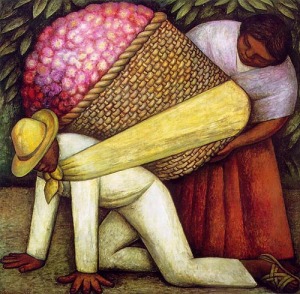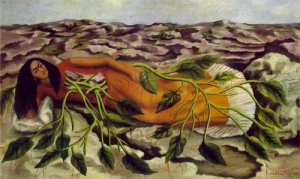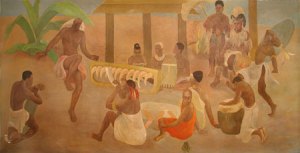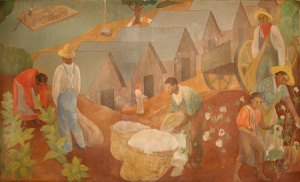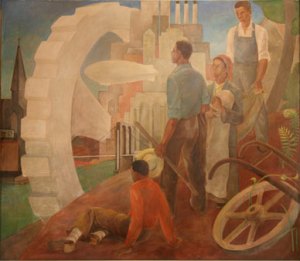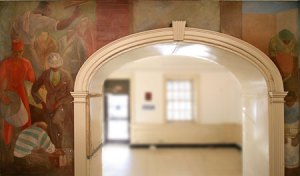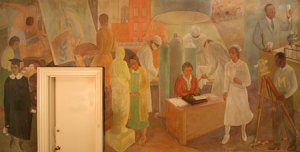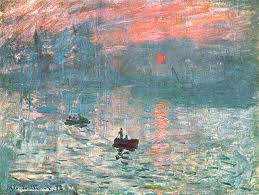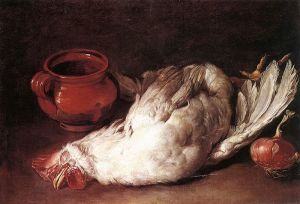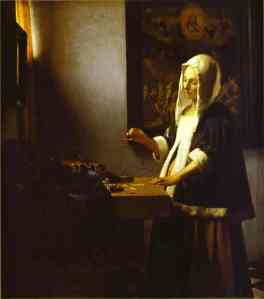Edgar Mueller is a famous street painter. He was born in Germany on July 10, 1968. He grew up in Straelen, Germany, which is a relatively rural town. His fascination with painting and art began early on in his childhood. He was intrigued by rural paintings of his hometown, Straelen and began to paint. Mueller attended high school in Geldern, Germany. It was there that the international competition of street painters took place. Inspired by the transitory works of art Mueller chose to enter the competition. He participated for the first time at the age of 16 and at age 19 won the competition! His winning piece was a copy of the famous, Jesus at Emmaus, 1987, Geldren, Germany. The Italian Baroque master Caravaggio did the original painting in 1601. I find all of Mueller’s work to be intriguing and aesthetically pleasing. I appreciate the religious relevance of this piece in particular. It is related to post-modern art in that it is transitory, therefore environmentally friendly and is also considered street art.

Mueller went on to participate in many more international street art competitions. He even earned the name “Maestro Madonnari”, aka master street painter. This title is given at the world’s largest street painting festival, the Grazie Festival, held in Grazie, Italy. At the age of twenty-five Mueller chose to devote himself entirely to street art. He traveled all over Europe making a living by creating his famous transitory works of art. He also gives workshops on street art, has co-organized various street art festivals, he set up the first German internet forum for street painters, and opened a studio in the street. His work is covered by many media outlets, including print and digital media.
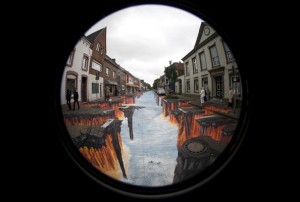 This painting, Use Your Eyes by Edgar Mueller was painted in August of 2008 inn Geldem, Germany during a competition of street artistry. This painting ties into the post-modern visual arts because it is classified as street art, but can also be considered environmental art, considering that it is a transitory piece. I really like the illusion the 3 dimensional image is able to produce.
This painting, Use Your Eyes by Edgar Mueller was painted in August of 2008 inn Geldem, Germany during a competition of street artistry. This painting ties into the post-modern visual arts because it is classified as street art, but can also be considered environmental art, considering that it is a transitory piece. I really like the illusion the 3 dimensional image is able to produce.
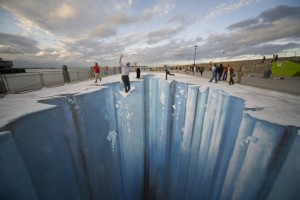 This piece, called Crevasse, also by Mueller was painted in Du Laoghaire, Ireland during the “Festival of Culture” which took place from August 21-24, 2008. Again, this piece is related to the post-modern era in that it is transitory and is a form of street art. I just am in awe of the ability this image has to manipulate the eyes and brain and create a 3 dimensional image on a side walk.
This piece, called Crevasse, also by Mueller was painted in Du Laoghaire, Ireland during the “Festival of Culture” which took place from August 21-24, 2008. Again, this piece is related to the post-modern era in that it is transitory and is a form of street art. I just am in awe of the ability this image has to manipulate the eyes and brain and create a 3 dimensional image on a side walk.
Another street painter or chalk artist is Englishman, Julian Beever, fondly titled “Pavement Picasso”. He has made pavement drawings for over twenty years now and is internationally known. He is not limited to chalk art, however, he also paints murals, creates collages, and recreates the works of master oil painters. Beever was born in the United Kingdom in 1959. He learned the tricks of the trade while studying fine arts at the University of Leed, located in the United Kingdom. His early works were composed mainly of portraits of well-known people. His later and more popular 3 dimensional or “anamorphic” works were inspired by his curiosity. Beever is commonly commissioned to create transitory advertisements for many consumer companies, such as Aveeno.
 This piece by Julian Beever was commissioned by Aveeno and was used to celebrate the company’s new anti-aging skin care line. It is called Fountain of Youth, 2007, New York. I really like Beever’s style. This is one of my favorites. His work, just like Mueller’s is totally transitory and is considered to be street art.
This piece by Julian Beever was commissioned by Aveeno and was used to celebrate the company’s new anti-aging skin care line. It is called Fountain of Youth, 2007, New York. I really like Beever’s style. This is one of my favorites. His work, just like Mueller’s is totally transitory and is considered to be street art.
 This piece called, Politicians Meeting Their End by Beever was created in 1997 in England and was commissioned by Britain’s Channel Four News. This piece wasn’t a favorite of mine, but I still appreciate the illusion it possesses. It is another transitory image that is classified as street art.
This piece called, Politicians Meeting Their End by Beever was created in 1997 in England and was commissioned by Britain’s Channel Four News. This piece wasn’t a favorite of mine, but I still appreciate the illusion it possesses. It is another transitory image that is classified as street art.
 This piece by Beever simply called, Spiderman was composed on a London street. I was unable to find out when it was created, but know it was done after 1975. This is my all time favorite. I love the comical aspect and appreciate how the 3 dimensional image can look so real (if you’re at the right angle). This piece is transitory and considered to be street art.
This piece by Beever simply called, Spiderman was composed on a London street. I was unable to find out when it was created, but know it was done after 1975. This is my all time favorite. I love the comical aspect and appreciate how the 3 dimensional image can look so real (if you’re at the right angle). This piece is transitory and considered to be street art.
Both artists and their works are related to the visual arts of the post-modern era because they are considered “street art” and could also be classified as “environmental art” because the works are completely transitory. I find the work of both artists to be aesthetically pleasing and appreciate the time and effort it takes to think up and create these 3 dimensional images. It takes a hugely talented person to develop the technique to create this images capable of producing realistic illusions, depending on the angle! I really thought this form of art was neat.
Works Cited:
http://www.metanamorph.com/about
http://www.zimbio.com/Edgar+Mueller/articles/2/Edgar+Mueller+Amazing+3D+Sidewalk+Paintings
http://www.flickr.com/people/pavementpicasso/
